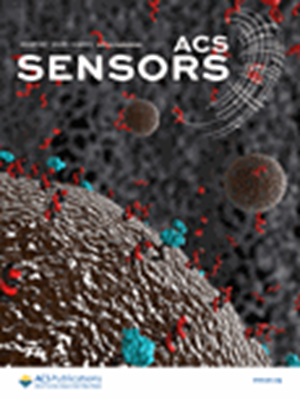基于Fe3O4@Gel的稳定磁弛豫开关传感器超快检测Cd2+
IF 8.2
1区 化学
Q1 CHEMISTRY, ANALYTICAL
引用次数: 0
摘要
为了克服传统磁弛豫开关(MRS)系统中信号不稳定和检测时间过长的双重挑战,设计了一种新型fe3o4包封藻酸盐水凝胶纳米复合材料(Fe3O4@Gel)传感器,用于快速筛选镉离子。与传统的基于Fe3O4的传感器相比,Fe3O4嵌入在凝胶网络框架中,避免了磁场诱导的聚集,这有助于提高MRS的稳定性。另一方面,与基于凝胶的MRS相比,Fe3O4加速了凝胶内部水分子的弛缓过程,传感器的检测时间在38 s以内。这是传统纯水凝胶磁松弛开关传感器191 s检测时间的五分之一。机制上,靶标诱导的免疫复合物的形成调节碱性磷酸酶活性,触发级联酶反应,精确调节水凝胶膨胀动力学。这种刺激响应行为将定量Cd2+浓度转化为可重复的横向松弛时间(T2)信号位移(R2 = 0.987),在线性(0.01-10 ng/mL)范围内实现亚ppt灵敏度(6 pg/mL)。在复杂基质中进行实际验证,回收率为96.62% ~ 109.97%。这种多功能纳米平台为复杂系统中高保真、现场可部署的危险筛查建立了新的范例。本文章由计算机程序翻译,如有差异,请以英文原文为准。

Stable Magnetic Relaxation Switch Sensor Based on Fe3O4@Gel for Ultrafast Detection of Cd2+
To overcome the dual challenges of signal instability and prolonged detection in conventional magnetic relaxation switching (MRS) systems, a novel Fe3O4-encapsulated alginate hydrogel nanocomposite (Fe3O4@Gel) sensor was designed for rapid screening of the cadmium ion. Compared with the traditional Fe3O4-based sensors, the Fe3O4 was embedded in the gel network framework to avoid magnetic field-induced aggregation, which helped to improve the stability of MRS. On the other hand, compared with MRS based on gel, the Fe3O4 accelerated the relaxation process of water molecules inside the gel, obtaining a fast detection time of the sensor within 38 s, which is one-fifth of the detection time of the traditional magnetic relaxation switch sensor with pure hydrogel of 191 s. Mechanistically, target-induced immunocomplex formation modulates alkaline phosphatase activity, triggering cascade enzymatic reactions that precisely regulate hydrogel swelling dynamics. This stimuli-responsive behavior translates quantitative Cd2+ concentrations into reproducible transverse relaxation time (T2) signal shifts (R2 = 0.987), achieving sub-ppt sensitivity (6 pg/mL) across linearity (0.01–10 ng/mL). Practical validation in complex matrices demonstrated 96.62%–109.97% spike recoveries. This multifunctional nanoplatform establishes a new paradigm for high-fidelity, field-deployable hazard screening in complex systems.
求助全文
通过发布文献求助,成功后即可免费获取论文全文。
去求助
来源期刊

ACS Sensors
Chemical Engineering-Bioengineering
CiteScore
14.50
自引率
3.40%
发文量
372
期刊介绍:
ACS Sensors is a peer-reviewed research journal that focuses on the dissemination of new and original knowledge in the field of sensor science, particularly those that selectively sense chemical or biological species or processes. The journal covers a broad range of topics, including but not limited to biosensors, chemical sensors, gas sensors, intracellular sensors, single molecule sensors, cell chips, and microfluidic devices. It aims to publish articles that address conceptual advances in sensing technology applicable to various types of analytes or application papers that report on the use of existing sensing concepts in new ways or for new analytes.
 求助内容:
求助内容: 应助结果提醒方式:
应助结果提醒方式:


